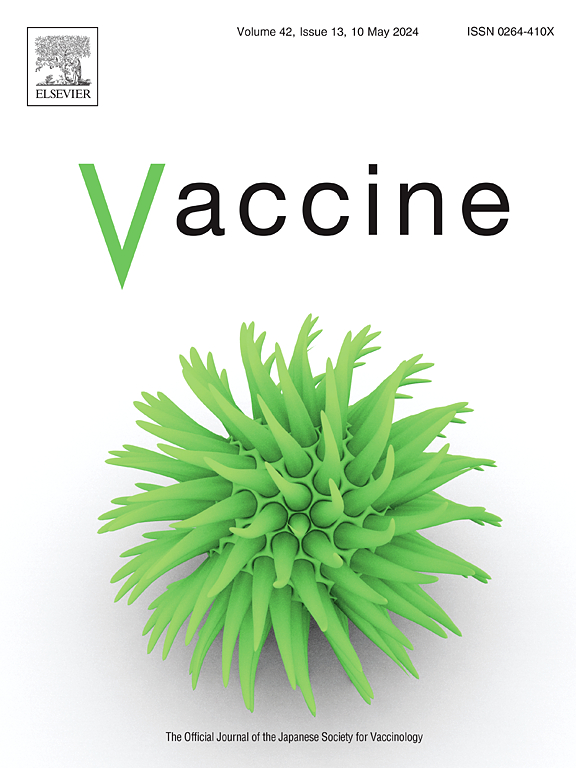Randomised controlled trials of behavioural nudges delivered through text messages to increase influenza and COVID-19 vaccine uptake among pregnant women (EPIC study) in Australia
IF 4.5
3区 医学
Q2 IMMUNOLOGY
引用次数: 0
Abstract
Background
Influenza and COVID-19 vaccine uptake among pregnant women is sub-optimal. We assessed the effectiveness of a multi-component behavioural nudge intervention to improve COVID-19 and influenza vaccine uptake among pregnant women.
Methods
A ‘nudge’ was developed that comprised three SMS text message reminders with a social norming message, links to vaccine safety information, videos of health professionals and consumers recommending vaccination in pregnancy and a pledge to get vaccinated. In separate RCTs, pregnant women who had not received an influenza vaccine during the 2023 influenza season, or received ≤2 doses of a COVID-19 vaccine, were randomised (1:1) to standard care or intervention at four hospitals in Australia.
Results
A total of 1090 and 1068 pregnant women were randomised to the COVID-19 and influenza RCTs, respectively. The nudges resulted in a 1.6 % increase in COVID-19 vaccine uptake and 1.7 % increase in influenza vaccine uptake among pregnant women. However, there was no significant difference in the percentage of pregnant women in the intervention (2.7 %) and the standard care (1.1 %) groups receiving one dose of a COVID-19 vaccine from randomisation until delivery (odds ratio, 2.40; 95 % confidence interval [CI], 0.91 to 6.30, P = 0.08). Similarly, there was no significant difference in the percentage of pregnant women in the intervention (58.0 %) and the standard care (56.3 %) groups receiving the influenza vaccine from the time of randomisation until delivery (odds ratio, 1.07; 95 % CI, 0.84 to 1.38, P = 0.58). Less than 2 % of women had viewed the video content of the nudges in both RCTs.
Conclusions
The nudges delivered via SMS resulted in small increases in COVID-19 and influenza vaccination uptake among pregnant women. Considering the very low cost of bulk SMS, these nudges may be cost-effective interventions at a population level.
澳大利亚的随机对照试验,通过短信进行行为推动,以增加孕妇对流感和COVID-19疫苗的吸收(EPIC研究)
背景孕妇的流感和COVID-19疫苗接种率不理想。我们评估了多成分行为助推干预对改善孕妇COVID-19和流感疫苗摄取的有效性。方法开发了一个“助推”,包括三条带有社会规范信息的短信提醒、疫苗安全信息链接、卫生专业人员和消费者建议在怀孕期间接种疫苗的视频,以及接种疫苗的承诺。在单独的随机对照试验中,在2023年流感季节未接种流感疫苗或接种了≤2剂COVID-19疫苗的孕妇被随机(1:1)分配到澳大利亚四家医院的标准护理或干预组。结果共有1090名孕妇和1068名孕妇被随机分为COVID-19和流感随机对照试验。轻推导致孕妇COVID-19疫苗接种率增加1.6%,流感疫苗接种率增加1.7%。然而,从随机分配到分娩,接受一剂COVID-19疫苗的干预组(2.7%)和标准护理组(1.1%)的孕妇百分比没有显著差异(优势比,2.40;95%置信区间[CI], 0.91 ~ 6.30, P = 0.08)。同样,干预组(58.0%)和标准护理组(56.3%)的孕妇从随机分组到分娩时接种流感疫苗的比例也没有显著差异(优势比,1.07;95% CI, 0.84 ~ 1.38, P = 0.58)。在两项随机对照试验中,只有不到2%的女性观看了轻推的视频内容。结论短信推送导致孕妇COVID-19和流感疫苗接种率小幅上升。考虑到批量短信的成本非常低,这些推动在人口水平上可能是具有成本效益的干预措施。
本文章由计算机程序翻译,如有差异,请以英文原文为准。
求助全文
约1分钟内获得全文
求助全文
来源期刊

Vaccine
医学-免疫学
CiteScore
8.70
自引率
5.50%
发文量
992
审稿时长
131 days
期刊介绍:
Vaccine is unique in publishing the highest quality science across all disciplines relevant to the field of vaccinology - all original article submissions across basic and clinical research, vaccine manufacturing, history, public policy, behavioral science and ethics, social sciences, safety, and many other related areas are welcomed. The submission categories as given in the Guide for Authors indicate where we receive the most papers. Papers outside these major areas are also welcome and authors are encouraged to contact us with specific questions.
 求助内容:
求助内容: 应助结果提醒方式:
应助结果提醒方式:


